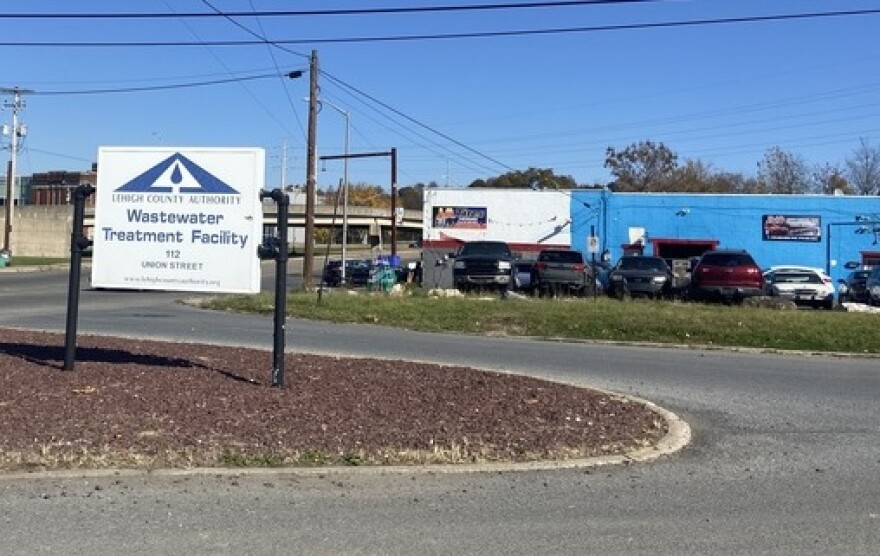ALLENTOWN, Pa. — The Kline’s Island Sewer System, or KISS, regional wastewater plan modernizes the way communities in the Lehigh County Authority’s service area work together, Liesel M. Gross said.
“Instead of having each individual municipality have its own plan, they're now part of a greater regional plan," said Gross, chief executive officer of the nonprofit water and wastewater utility.
"So that we can work together more collaboratively on the solutions and plan for the future together.
“That's what we're hoping to accomplish.”
Almost a year and a half after LCA officials announced a more-than-half-billion-dollar plan for much needed upgrades to wastewater infrastructure over the next decade across more than a dozen municipalities, including the city, that plan has been submitted to local officials for review.
"We have been working on it for many years... But to have a final plan that we're generally comfortable with getting out to the community is really a great accomplishment for the region.”Liesel M. Gross, Lehigh County Authority chief executive officer
There have been some changes, including a major decrease in cost and a slight shift in focus.
While the 10-year plan’s estimated cost now sits at $318 million, officials have prioritized the most-needed projects.
For that, there’s a five-year plan, with a projected price tag of $135 million.
“I will say it's a real relief, in a way, to get it out there and get it into the municipalities' hands for their review, for public review," Gross said in a recent interview.
"And be working toward a final plan that we can submit to [the state Department of Environmental Protection] later this year.
"And we have been working on it for many years. A lot of hard work went into it, a lot of great engineering.
"But to have a final plan that we're generally comfortable with getting out to the community is really a great accomplishment for the region.”
‘The time is now’
Gross last Monday gave a presentation on the KISS regional wastewater plan during LCA’s board meeting.
“Right now, we're going through a round of municipal planning commission reviews and just sharing the message that we've been working on this for a very long time,” Gross said.
“The time is now to get this plan together, get it submitted and start doing the projects and doing work — recognizing that some components of the plant are almost 100 years old.”Liesel M. Gross, Lehigh County Authority chief executive officer
“The time is now to get this plan together, get it submitted and start doing the projects and doing work — recognizing that some components of the plant are almost 100 years old.”
Much of the system, including Kline's Island Wastewater Treatment Plant on Union Street, includes parts installed between the 1920s and the 1980s.
The comprehensive plan, which spans almost 600 pages including appendices and exhibits, includes plans for all 15 municipalities in the LCA’s service area.

In addition to the city, that includes: Emmaus, Macungie, Alburtis, Coplay, Upper and Lower Macungie townships, as well as North and South Whitehall, Salisbury, Whitehall, Upper Milford, Hanover, Weisenberg and Lowhill townships.
Some municipalities are only partly covered by the system. In those cases, officials are responsible for separate Act537 plans in addition to the regional plan.
A cost breakdown for the five-year plan included estimates of $55 million to $60 million for municipal sewer rehabilitation projects; $60 million to $65 million for the Kline’s Island Wastewater Treatment Plant; and $8 million to $10 million for the Western Lehigh Interceptor System.
‘Pay dividends in the long run’
The comprehensive plan, posted on the dedicated website created for the project, has municipal-specific information throughout, including histories of wastewater planning throughout the region.
“Municipal leaders … have been meeting every single month together as a group to work on this,” Gross said.
“So there are relationships that have been formed, and the understanding among the municipalities that has been formed through this process is going to pay dividends in the long run.
“We now have some municipalities that are working together on joint purchasing contracts for rehab work or for materials, and that saves us money and time, as well.”
“We instead decided that the best approach is to really work on repairing and rehabilitating the system that we have."Liesel M. Gross, Lehigh County Authority chief executive officer
Earlier iterations of the plan also included work at the industrial pretreatment plant, 7676 Industrial Road, Upper Macungie Township, but it was excluded from the most recent version.
“Ultimately, that is not the direction that the region decided to go,” Gross said. “We instead decided that the best approach is to really work on repairing and rehabilitating the system that we have.
"And then working on some upgrades at the Kline's Island plant to handle peak flows.
“So essentially what that means then is that the pre-treatment plant will continue to be sort of a standalone asset that provides service to a small number of very distant industrial customers, and we can address that directly with those customers.”
‘Quite a bit of work’
Specific plans for each municipality are outlined in Appendix 7. They include studies, as well as how officials plan to address inflow and infiltration issues, and manhole and sewer rehabilitation work, plotted out over the next decade.
Rate projections were not included, as each municipality may calculate rates differently, Gross said.
However, there is a table showing the shared costs of upgrades per 1,000 gallons, giving “an idea of how the costs will be increasing over time for those municipalities.”

For example, for fiscal year 2026 in Allentown, the graph shows it costs $2.86 per 1,000 gallons.
“That's not the rate that customers pay, but it's a representation of the KISS costs across the flows that come from Allentown,” Gross said.
“And then you can see it increases over the five-year period, because there's quite a bit of work that has to happen in the Allentown sewer collection system.”
Plans in mid-April were sent to municipal leaders for review and approval. They have until mid-June to submit comments back to LCA.
After incorporating those into the plan, it goes under a 30-day public comment period.
Once those comments are added to the plan, the municipal adoption process will begin. If adopted, the plan will go to the DEP for review and approval.
‘A true regional effort’
The issues with the system that sparked the current plan stretch to 2007, when the U.S. Environmental Protection Agency began regulatory action because of aging infrastructure and overflows, among other issues.
There were additional overflow issues in 2019.
“We went right back under a DEP corrective action plan because of the high flows that we had during the wet period of 2018 and 2019,” Gross said.
“From that period of time, when it was really wet, we had high flows consistently coming through the system, such that we had a permit violation, or what we call a Chapter 94 violation.”
Chapter 94 of the Pennsylvania Code deals with municipal waste management.
During talks with DEP officials to remedy the violation, LCA officials saw the need for a comprehensive, regional Act537 plan.
Those plans, required by all municipalities, “provide for the resolution of existing sewage disposal problems, provide for the future sewage disposal needs of new land development, and provide for future sewage disposal needs of the municipality,” according to the DEP’s website.
Solving issues, saving money
Before 2020, the municipalities were "all working more individually on sewer rehab programs, various modeling studies and metering, flow monitoring, that sort of thing,” Gross said.
“But really in 2019 and 2020 began really consolidating that effort into a true regional effort to create this plan that will be more comprehensive in terms of solving the issues.”
After announcing the initiative in November 2023, LCA officials held several open houses to collect feedback and answer questions from residents.
“It really just puts it in a more comprehensive, holistic view of what the system needs, and, in the long run, that should save everybody some money.”Liesel M. Gross, Lehigh County Authority chief executive officer
The regional plan is a collaborative effort, addressing the network of facilities connected to Kline’s Island for final treatment — there’s 1,000 miles of pipe serving 270,000 people.
“Having that a little more regionally managed, at least from the standpoint of planning for the future, planning for the large infrastructure investments and helping each community understand what they need to do to address their own collection systems,” Gross said.
“It really just puts it in a more comprehensive, holistic view of what the system needs, and, in the long run, that should save everybody some money.”


